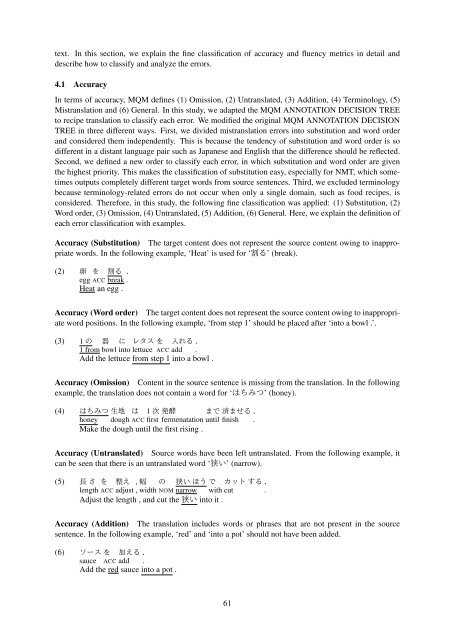December 11-16 2016 Osaka Japan
W16-46
W16-46
You also want an ePaper? Increase the reach of your titles
YUMPU automatically turns print PDFs into web optimized ePapers that Google loves.
text. In this section, we explain the fine classification of accuracy and fluency metrics in detail and<br />
describe how to classify and analyze the errors.<br />
4.1 Accuracy<br />
In terms of accuracy, MQM defines (1) Omission, (2) Untranslated, (3) Addition, (4) Terminology, (5)<br />
Mistranslation and (6) General. In this study, we adapted the MQM ANNOTATION DECISION TREE<br />
to recipe translation to classify each error. We modified the original MQM ANNOTATION DECISION<br />
TREE in three different ways. First, we divided mistranslation errors into substitution and word order<br />
and considered them independently. This is because the tendency of substitution and word order is so<br />
different in a distant language pair such as <strong>Japan</strong>ese and English that the difference should be reflected.<br />
Second, we defined a new order to classify each error, in which substitution and word order are given<br />
the highest priority. This makes the classification of substitution easy, especially for NMT, which sometimes<br />
outputs completely different target words from source sentences. Third, we excluded terminology<br />
because terminology-related errors do not occur when only a single domain, such as food recipes, is<br />
considered. Therefore, in this study, the following fine classification was applied: (1) Substitution, (2)<br />
Word order, (3) Omission, (4) Untranslated, (5) Addition, (6) General. Here, we explain the definition of<br />
each error classification with examples.<br />
Accuracy (Substitution) The target content does not represent the source content owing to inappropriate<br />
words. In the following example, ‘Heat’ is used for ‘’ (break).<br />
(2) <br />
egg ACC break .<br />
Heat an egg .<br />
Accuracy (Word order) The target content does not represent the source content owing to inappropriate<br />
word positions. In the following example, ‘from step 1’ should be placed after ‘into a bowl .’.<br />
(3) 1 <br />
1 from bowl into lettuce ACC add .<br />
Add the lettuce from step 1 into a bowl .<br />
Accuracy (Omission) Content in the source sentence is missing from the translation. In the following<br />
example, the translation does not contain a word for ‘’ (honey).<br />
(4) 1 <br />
honey dough ACC first fermenatation until finish .<br />
Make the dough until the first rising .<br />
Accuracy (Untranslated) Source words have been left untranslated. From the following example, it<br />
can be seen that there is an untranslated word ‘’ (narrow).<br />
(5) , <br />
length ACC adjust , width NOM narrow with cut .<br />
Adjust the length , and cut the into it .<br />
Accuracy (Addition) The translation includes words or phrases that are not present in the source<br />
sentence. In the following example, ‘red’ and ‘into a pot’ should not have been added.<br />
(6) <br />
sauce ACC add .<br />
Add the red sauce into a pot .<br />
61



